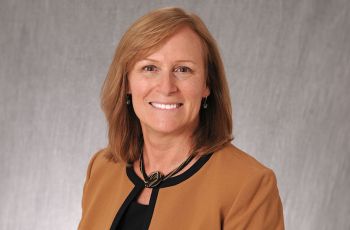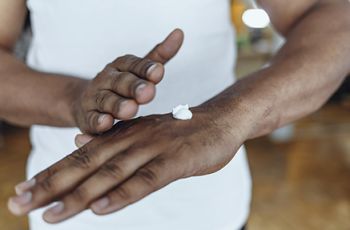The southeast African country of Mozambique has endured a tumultuous past. Battered by civil war until 1992, the nation now faces an enemy just as fierce: HIV/AIDS. Though modest in size — about half the size of Alaska — the country has the fourth-largest number of people living with HIV in the world. Approximately 1.8 million citizens, or nearly 16 percent of the country, are infected, and thousands are born with the virus each year.
Far away, in a quiet laboratory in GW Medical Center’s Ross Hall, Jeanne Jordan, Ph.D., professor of Epidemiology in the School of Public Health and Health Services, seems removed from this crisis. But since witnessing the epidemic last year during a visit to Mozambique, the researcher has been determined to have an impact.
Jordan’s inspiration stems from a meeting with Ilesh Jani, M.D., Ph.D., director of Mozambique’s National Institute of Health. In recent years, the institute has focused on the country’s youngest HIV/AIDS patients by launching an Early Infant Diagnosis plan in 2007 to identify HIV-positive babies and treat them as soon as possible. Under the plan, rural health center staffers are trained to collect dried blood spots for HIV diagnosis. With large-scale infant diagnosis under way, the challenge now facing the institute is timing. Under the current diagnostic method, dried blood spots are shipped from village health clinics to provincial labs, and then to one of two central reference laboratories in the country for testing. By the time the results get back to the local clinics, two months or more may have elapsed. For the families, who may hear the results even later due to Mozambique’s poor communications infrastructure, that wait is too long.
Jordan and Jani’s meeting, however, sparked an exciting idea. “We thought it would be really effective to decentralize the process so that provincial labs could do the testing rather than having to send it off to some place that might be hundreds of miles away,” Jordan recalls. By performing tests closer to the point of care, workers could shorten the time between identifying HIV-positive infants and getting those infants into treatment. This, they thought, was something that could dramatically improve outcomes and save young lives.
But there was a reason no one had tried it before: Provincial labs in Mozambique are rarely more sophisticated than a single room with a sink, refrigerator, and microscope. Provincial testing “couldn’t be done with the current process used in the central reference lab because of the cost of the equipment, the highly complex technology, and the training needed,” Jordan explains. But she saw a potential way to circumvent that challenge, and, since her return to the United States, has been evaluating virtually instrument-free HIV detection tests for use in even the most basic labs.
Diagnosing newborns with HIV poses a unique challenge. Unlike adults, who are tested for the presence of HIV antibodies, infants must be tested for HIV genetic material itself. Because maternal IgG antibodies cross the placental barrier, children cannot be tested for their own antibodies to HIV without risk of a false-positive test until they are about 18 months of age. “But by 18 months, infected infants would be well on the way to being extremely ill or dying,” says Jordan, adding that 50 percent of babies born with HIV and left untreated die before their second birthday. “It’s really essential for these infants to have access to a molecular test early in their lives to determine if they need to be in treatment.”
The internationally accepted diagnostic approach for infant HIV testing is twofold. First, technicians extract nucleic acid from a dried blood spot. Next, they conduct amplification tests of the extracted material for HIV-1. Highly trained technicians, specialized equipment, and extensive protocols are required for both steps, so an instrument-free methodology must address them in tandem.
Jordan identified HandyLab, a Michigan-based company that was developing reagents that could be put on an automated extraction instrument. Interested in translating HandyLab’s techniques into a manual approach, Jordan worked with the company to develop an extraction method that would require only the use of a magnet, heating block, and pipettes.
BioHelix Corporation, a Massachusetts-based startup, was a prime candidate for the second step in the process. The company had been working on a nucleic acid amplification test using a disposable cassette-based method. Its approach, too, required only simple devices. “You could essentially even use a car battery or solar panel as your power source for the heating block that is needed for the isothermal amplification step,” Jordan notes.
Though these approaches differ from the standard protocols, Jordan hopes that they will be just as effective in detecting HIV in infants. So far, results are promising: The methods have “very good correlation and a very good level of sensitivity,” she says. Because most samples she has accessed are subtype B cases from the United States, Jordan is partnering with two labs specializing in international work to better diagnose different HIV subtypes, including subtype C, which is the most common type in Mozambique.
The next step will be translating this lab work into the field. Jordan has partnered with the Elizabeth Glaser Pediatric AIDS Foundation (EGPAF), the Association of Public Health Laboratories (APHL), and Jani to submit a proposal to Grand Challenges Canada (a not-for-profit organization dedicated to improving health in developing countries). The proposal, if accepted, will provide comprehensive training, protocols, and quality measures for provincial lab technologists in two laboratories in Mozambique. Meanwhile, EGPAF, which supports the national HIV program in four local provinces, will enroll infants in nearby clinics for implementation research. The project will evaluate — in a true-to-life setting — how the instrument-free approaches compare to the current detection methods.
“We’re excited to bring Dr. Jordan’s work to the field, where it has the real potential to save many lives,” says Nicholas Hellmann, M.D., EGPAF’s executive vice president of medicaland scientific affairs. “For us, time isof the essence for identifying and treating HIV-positive infants. Working in local settings with relatively low-tech solutions is often the key to scaling up treatment for the most vulnerable populations.”
Jordan is eager to see how these methods can improve the health landscape in Mozambique. In the meantime, she’s looking even farther ahead. She’s identified two companies — Micronics, in Redmond, Wash., and Wave 80 Biosciences, in San Francisco — that are developing true point-of-care diagnostic tools. The goal is to produce a small instrument activated by a limited power source that would combine the extraction and amplification steps into one, giving results directly from blood or dried blood spots. It may be a year or more before testing can begin, but the possibilities are promising.
“We hope to move the testing from the provincial labs to local clinics and maternity hospitals,” says Jordan, “where nurses and midwives could do the testing at the true point of care.”


